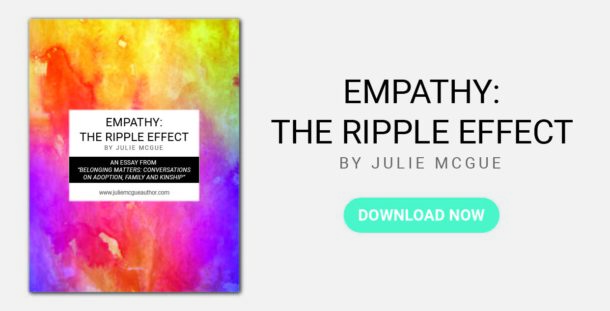The First 2 Steps In An Adoption Search

Julie McGue
Author
Talk to your adoptive parents.
I know this is easier said than done. Not every adoptee tackles this as their first search step, but eventually obligation and guilt weighs in and this very difficult conversation must be put on the calendar.
If you are an adoptee from the Baby Scoop Era (that era after WWII through the ‘70s before birth control was an accepted practice), your adoption was probably closed. Closed adoption means that the adoption records were legally sealed to protect not only the rights of adoptive parents but also the rights and identities of birth parents. It also means that your right to information is limited depending on the state where your adoption was legalized. Discussing your adoption with your adoptive parents, assuming they are still living, may provide helpful information that will speed up your search time.
Regardless of whether your adoption was closed or open, or whether your state cooperates with releasing original birth records, sharing your plans with your adoptive parents is an important step. Sitting down with them is sure to unleash a myriad of worries and problems for everyone involved. Being honest and open about your plans and unveiling why you’ve chosen this time in your life to explore your biological roots will settle everyone’s nerves. It also sets the stage for what might occur after your search: the reunion phase.
I chose to search for my birth mother after several suspicious mammograms begged a breast biopsy. My need for health and family history put my adoptive parents squarely on my side, but initiating the talk was nerve racking. Letting them know that I cared for them and that no one could take their place in my life set the conversation off in the right direction. Having my parents as part of my support team before I launched my search was crucial to me. Their support gave me the confidence to proceed.
Gather your documents and obtain all non-identifying information.
Collect everything you can:
- adoption papers,
- birth certificate (even if all you have is the redacted one),
- baptismal certificate,
- adoption agency- including the name and address,
- adoption attorney,
- hospital where you were born,
- anyone associated with your adoption- such as the social worker or case manager.
If your state laws provide for the release of your original birth certificate or birth record (OBC or OBR) submit the application right away. If your state’s laws do not allow this disclosure, know that you are entitled by law to obtain all the non-identifying information enclosed on the document.
The same rule applies to the adoption agency’s records. If it was a private agency, it may be their policy to protect the identity of the birth parents; however, the agency must comply with your request for the non-identifying information contained in their files. Possessing this information can be very helpful later on as you zero in on your birth relative’s whereabouts.
In my case, the physical description of my birth father and several other facts provided by the adoption agency were instrumental in locating him. I was not given the proper spelling of my birth father’s last name, but a researcher was able to discern his identity from city directories because of the non-identifying information I had requested.
All information you can obtain related to your adoption should be considered useful. Think of your task as assembling all the pieces of a jigsaw puzzle. You never know where all pieces fit in to the overall frame until you starting working a section. You may have to work tirelessly at your search puzzle, but hopefully it will all come together.
I spent almost four years assembling my personal story. There were moments when I felt like quitting, when the roadblocks seemed insurmountable, then in one short week the missing piece fell into place. The rest of the story is why memoirs are written.
“There were moments when I felt like quitting, when the roadblocks seemed insurmountable, then in one short week the missing piece fell into place. The rest of the story is why memoirs are written.”

Snag my in-depth reference guide to best equip you for the journey ahead.



0 Comments